How to Get Rid of Nitrites in Aquarium
Let's face it, nobody wants nitrites in their aquarium.
I don't want them. You don't want them. Your fish certainly don't want them.
Even though nitrites are unwanted, they actually play an essential role in your aquarium.
Today, I'm going to teach you everything you would want to know about them.
Before I continue, I want to make sure you read The Nitrogen Cycle guide.
Doing so will make what I am about to tell you much easier to understand. If you are a beginner to the hobby, I highly recommend it!
Up to speed?
Good.
Then, let's continue…
What are aquarium nitrites and where do they come from?
Pronounced nigh-trights, nitrites (NO2) are a form of dissolved nitrogen that occur naturally in the water column, which is the water inside your aquarium.[1]
How nitrites end up in your aquarium is quite a journey.
And, it all starts with waste.
Without waste, nitrites wouldn't exist.
Common sources of waste found in aquariums include:
- Uneaten fish food
- Fish poop
- Decaying plants
- Dirty filters
While waste leads to the appearance of nitrites, it is not the defining cause.
To explain, here is a very brief recap of the nitrogen cycle.
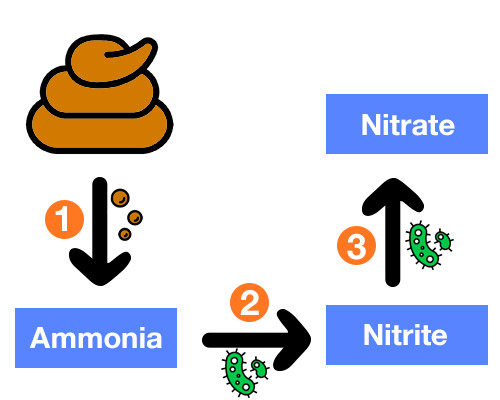
1. As waste breaks down, it gives off ammonia.
2. A bacteria called nitrosomonas breaks down the ammonia into nitrites.
3. A second bacteria, called nitrobacter, then feeds on the nitrites and produces nitrates.
So, nitrites wouldn't exist without ammonia.
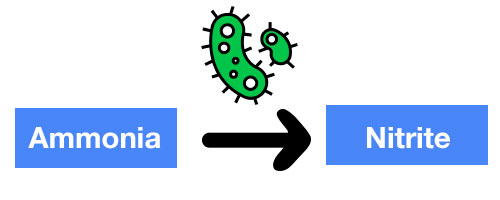
The process of ammonia being converted into nitrites by bacteria is called nitrification.
What nitrite levels are acceptable in your aquarium?
The acceptable level of nitrites in your tank is…
Zero.
Yep, you read that right…
Nitrites are pretty bad news. So, in a stocked tank, the level should read 0 ppm (parts per million).
The bacteria in an established tank should exist in high enough numbers to break down nitrites the moment they are produced – leading to a zero reading when tested.
If your nitrite levels are higher than zero, you need to find the cause of the problem, and fast.
However, there is an obvious exception to this rule…
When cycling a new tank.
In a new tank, bacteria doesn't exist in large enough numbers to break down the nitrites as they are produced.
This is actually a big part of why you need to cycle your aquarium – to allow the bacteria that live in your biological filter, which break down nitrites, to grow.
So if you are cycling a new tank, expect high levels of nitrites.
What happens if your aquarium nitrite levels are too high?
Once nitrite levels exceed zero, they are going to be absorbed by your fish – they have no choice in the matter.
When the nitrites reach the fish's blood stream, they stop the blood from carrying oxygen. The more nitrites that are taken in by your fish, the less oxygen the blood can carry.[4]
Oxygen is kind of a big deal because your fish need it to live.
So, I am sure you know what happens if your fish take in too many nitrites, right?
Suffocation!
What a horrible way to go.
What's interesting is that it doesn't matter how oxygenated your aquarium is, your fish can still suffocate.
An aquarium with all the aquarium bubblers and surface agitation in the world isn't going to help your fish if they cannot draw oxygen out of the water.
This entire process is referred to as nitrite poisoning.
Important: Don't confuse nitrites with nitrates. While there may only be one letter differentiating them, the two are very different.
The toxicity of nitrites depends entirely on the species of fish. While some are quite tolerant, others will die at the faintest hint. For some fish, just 0.29 ppm of nitrites leads to death.[4]
But just because your fish can tolerate it, that doesn't mean it is healthy. Your fish are likely under an incredible amount of stress….
When fish are stressed, they are more likely to develop diseases, lose their color, suffer from stunted growth or even become unable to reproduce.[4]
It's simple – keep your nitrite levels at zero for happy and healthy fish.
FishLab Fact: Chloride reduces how many nitrites your fish take in. And, you know what has lots of chloride in it? Salt. For this reason, marine fish are more tolerant of nitrites than freshwater fish.
What causes high nitrite levels in aquariums?
Does your tank feature any of the following?
- Over feeding
- A sudden buildup of waste
- No nitrifying bacteria in the filter
- Weak filtration
- Overstocked aquarium
If so, your tank is at a high risk of elevated nitrite levels.
FishLab Fact: A sudden jump in nitrite levels is called a nitrite spike.
Also, if there is a sharp rise in ammonia levels, a sharp rise in nitrites will soon follow.
Why?
The bacteria responsible for turning ammonia into nitrites rapidly multiply because their food source has become bigger – releasing more nitrites than your tank can handle.
As you may have noticed, most of the causes of high nitrite levels can be fixed with good housekeeping and regular maintenance.
How do you test for nitrites?
Nitrite testers are readily available at pet shops, fish stores and even online.
Let's take a closer look at some of the most popular nitrite testers on the market.
API Nitrite Test Kit
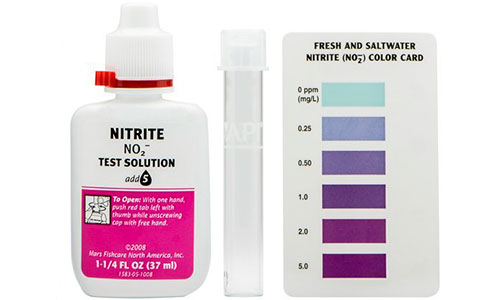
Lasts up to 180 tests
When it comes to measuring your nitrite levels, an aquarium test kit is the simplest and cheapest way to do it.
If you walk into your local fish store, this will likely be the nitrite test kit that they keep on the shelf. API test kits can be found almost anywhere.
That's not a bad thing. API nitrite test kits are cheap, and they work well enough. For the average hobbyist, these are fine.
If you purchased the API Master Test Kit, then you will already have this test kit, along with many others.
However, like many nitrite test kits, this one has a shortcoming.
It's all thanks to amine interference.[1]
In certain instances, such as reef tanks, essential amino acids can cause these tests to show a lower nitrite level than what is actually occurring in your tank.
And, that could prove to be deadly.
Fortunately, there are nitrite tests available that get around this issue.
Unfortunately, many of these test kits are expensive.
But not this one…
Salifert Nitrite NO3 Test Kit
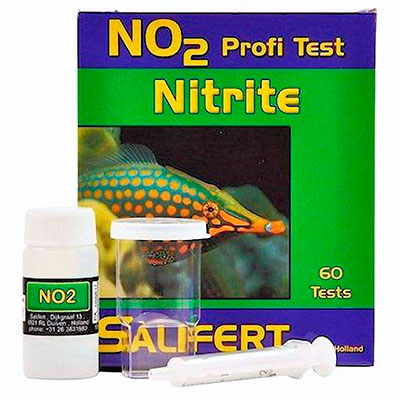
Lasts up to 60 tests
This nitrite test kit hits the sweet spot for both price and performance.
It may not last as long as the API test kit, but it makes up for this by being easy to use with accurate results – no amine interference here!
The Salifert nitrite test kit is particularly popular with saltwater tank owners.[1]
I personally use Salifert because I find these kits easier to use.
Since it can be picked up for just a few more dollars than the API kit, I recommend making this your go-to nitrite test kit.
While nitrite test kits are easy to use, their accuracy depends on your ability to follow the instructions.
I highly recommend reading the instruction manual thoroughly before using a test kit. Skipping a simple step, such as shaking the bottle, can cause an incorrect reading.
Hanna Nitrite Colorimeter
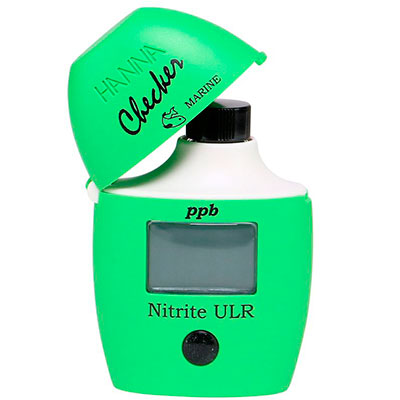
If you want to spend a bit more cash for the sake of accuracy, Hanna Instruments' nitrite checker bridges the gap between the cheaper chemical test kits and the more pricey probe meters.
Simply add your water sample, combine with the reagent from the kit, and the checker will give you a digital readout.
While the checker comes with some reagent, you will burn through it quickly. Refill packs are readily available, but they will be an ongoing cost.
Just make sure you get the correct reader for your aquarium – the freshwater nitrite monitor can give an incorrect reading if used with saltwater.
How do you reduce nitrite levels?
Just tested your nitrite levels and discovered they are shockingly high?
Don't panic!
I am going to talk you through everything you need to do in the event of a nitrite spike.
1. Water change!
A 30-50% water change should be the first thing you do after confirming a nitrite spike.
You are swapping out nitrite-filled water for water that is nitrite-free.
What you are essentially doing is diluting the amount of nitrites that are present in your aquarium.
Performing a water change will buy time until you can use another method listed below to get your nitrites under control.
2. Add cycled filters
As I touched on earlier, bacteria turn nitrites into much less harmful nitrates.
In large enough numbers, these bacteria eat nitrites as fast as they are produced.
So, what you are doing is introducing more of them into your aquarium.
You see, in a cycled tank, these bacteria are present in large numbers in the filter.
By adding a filter from a cycled tank into an aquarium with a nitrite spike, the bacteria start eating all the nitrites, lowering the levels.
But if you don't have multiple tanks, tracking down a cycled filter can be difficult. If you have a good relationship with your local fish store, they may allow you to take one.
FishLab Tip:If you have more than one tank, use a sponge filter to cycle multiple filters at once. If a cycled filter is needed, simply remove a sponge filter from one tank and add it to another.
3. Water conditioner
This is essentially a nitrite remover in a bottle. Simply follow the directions and watch the nitrites disappear from your aquarium as if by magic.
Water conditioners bind the nitrites, thus rendering them harmless to fish and giving your filter bacteria the opportunity to catch up and turn them into nitrates.
I make it no secret that my favorite water conditioner is Seachem Prime…
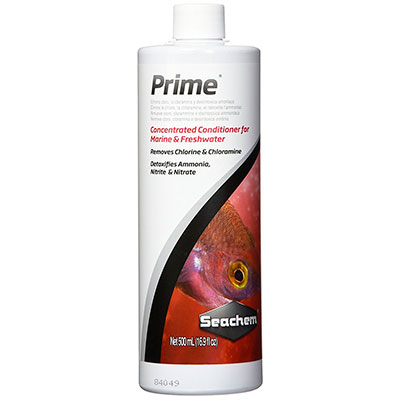
Not only does it detoxify nitrites, but it also deals with nearly any other water quality issue that may arise![2]
I highly recommend keeping a bottle on hand in case of an emergency.
And trust me, a nitrite spike definitely classifies as an emergency.
While these methods help reduce nitrite levels, they do not stop the cause of the spikes.
With the nitrite levels under control for the moment, you now have time to track down the cause of the problem.
How do you prevent nitrites from building up?
If you read my guides on ammonia and nitrates, you are aware of the advice I am about to give you.
That's because ammonia, nitrite and nitrate share a common cause.
It all starts with waste.
By getting waste under control, you minimize any problems caused further down the nitrogen cycle.
While these tips won't remove or reduce existing nitrites in your aquarium, they will stop new nitrites from building up as quickly – which is a good thing!
1. Don't overfeed your fish!
The more your fish eat, the more they are going to poop. And, the more they poop, the faster the nitrites will build up inside your aquarium.
I would also add that any food that remains uneaten sinks to the bottom and rots. And, you know what that means? More nitrites and nitrates!
Remember, just because you don't overfeed your fish doesn't mean that someone else in your family isn't.
I learned this the hard way…
I kept finding uneaten pieces of food rotting in the corner of my tank. I feed my fish a premeasured amount, and they eat every last piece. But where this extra food was coming from had me stumped.
Well, it turned out my nephew was sneaking in and feeding the fish when I wasn't looking. Mystery solved.
2. Maintain your plants
If you have live plants in your tank, then you need to incorporate a bit of underwater gardening.
Old leaves on your plant are going to die.
When this happens, the leaves fall off and decay, which can lead to an increase in nitrite levels.
You can get ahead of this by doing a bit of light pruning.
Every time you see dead or dying bits of plant matter, snip them off and remove them from your aquarium.
3. Clean your filter
You know all those loose bits of food, plant matter and poop? Well, they are going to get sucked up and trapped by your filter.
Over time, this waste is going to accumulate.
Regular maintenance will stop the built-up waste from reaching problem levels.
One popular solution is to use an intake sponge filter – literally a sponge that covers the intake to your filter.
The sponge traps any gunk that floats through the water, trapping it before it reaches your filter.
Simply remove the sponge to clean it – no more taking your filter apart!
4. Buy a gravel vac
Your substrate can quickly become a graveyard of rotting fish food, dead plants and whatever else that gets caught up in it.
All of these contribute to nitrites forming in the water.
A gravel vac is one of the most effective ways to remove this from your substrate.
Easy to use, affordable and effective – if your tank has a substrate, there is little excuse for not owning a gravel vac.
Ideally, you should perform a gravel vac during most, if not all, water changes.
5. Monitor your stock
An overstocked aquarium will have more nitrite problems than an understocked one.
It's unavoidable. Too many fish in a small aquarium will create more waste than the tank can handle, which is a surefire recipe for a spike in nitrite levels.
If your tank is overstocked, you have two solutions:
- Get rid of some of your fish or
- Buy a larger aquarium.
I know it can be difficult to say goodbye to fish, but it's for their own good. They are just going to suffer in an overstocked tank anyway.
Or, if you don't want to say goodbye to your fishy friends just yet, buy a bigger tank.
You have been looking for a good excuse to buy a larger aquarium, and nitrite problems are as good a reason as any to make the upgrade!
Don't be tempted to buy more fish now that you have a larger tank – that's what got you into this whole mess in the first place.
Do you have any nitrite tips? Let me know in the comments below!
How to Get Rid of Nitrites in Aquarium
Source: https://fishlab.com/nitrite/